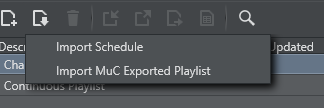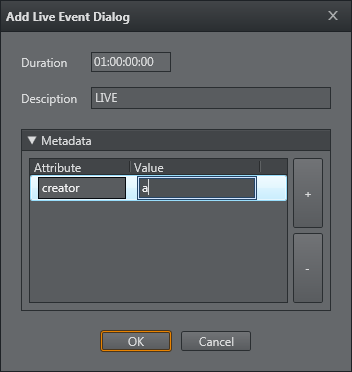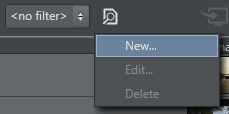
Viz Multichannel
Version 4.0 | Published January 23, 2019 ©
Playlists

The Playlists pane displays the playlist(s) created for the selected channel. Viz Multichannel supports two types of playlists; continuous and broadcast day playlist. In addition it features a default playlist named Channel Pool.
When a playlist is opened, the primary and secondary events will be displayed in the right pane. In the Playlist pane you can view all the playlists you have for a specific channel.
Right-clicking on a playlist in the left pane displays a context menu of playlist commands:
-
Update Playlist: allows you to select one of the following update options:
-
Full Update: updates the entire playlist, primary and secondary events.
-
Full Update Without Event Deletion: updates the entire playlist, primary and secondary events; however, it will not delete already added events.
-
Update Times: Allows you to only update the event times according to the imported schedule.
-
-
Delete Playlist: Deletes the playlist.
-
Export Playlist: Exports the playlist to a native Viz Multichannel XML format. You can, as part of the export, also export the Graphics and Data.
-
Send Playlist: Sends the playlist to the master control room.
-
Generate Report: Generates an HTML report of the selected playlist.
To Import a MuC Exported Playlist
A playlist that has previously been exported from MuC as an xml file, can be imported back using the Import MuC Exported Playlist menu item.
This will import the xml playlist to MuC without performing any mapping settings. Playlist data is set as it appears in the imported file.
If the contained broadcast date already exists, the existing playlist won't be replaced with the imported data. You must first delete the existing playlist.
-
Click the Import icon and select Import MuC Exported Playlist

This section presents:
Channel Pool
The Channel Pool playlist is intended for those elements that may require special handling, such as a logo, trouble slide, breaking news, and so on. These are accessible to and used, for example, by external control applications in order to trigger elements that are not scheduled in a normal playlist.
Pages added to the Channel Pool will, by default have the page name set as the Media ID. The Media ID can be changed manually by editing the Media ID column (per element). Enable editing by checking the Edit Events option for Media IDs in your mapping settings (e.g. Mapping Settings).
A separate channel pool is added for each channel.
Playlist Toolbar
The following table describes the different buttons, modes and status icons available to the playlist.
|
Icon |
Description |
|
|
When green the playlist is running. When gray the playlist has been stopped |
|
|
When a playlist is active it is added to the Media Sequencer. Once added to the Media Sequencer it will start to check that all resources (e.g. videos and imagery) are available (see Available status) to Viz Engine for playout. This means, amongst other things, that videos are transferred from e.g. Viz One to Viz Engine |
|
|
100% available means that full screen video clips are available to Viz Engine for playout |
|
|
100% loaded means that all pages (i.e. the actual graphics including embedded video clips and imagery) are loaded and ready for playout |
|
|
Enables you to run and stop the playlist. Note that in order to run the playlist successfully your elements must have a begin and end time |
|
|
Search enables you to search the description field of your playlist elements. To see the next result, press Enter |
|
|
Predefined filters allow you to filter the playlist. Click the funnel icon to create, edit or delete filters. See how To add a playlist filter. |
|
|
Takes the selected playlist element (or group of elements) on air |
|
|
Continues the animation of the playlist element |
|
|
Takes the current playlist element off air |
|
|
Initializes the playlist’s pages on the preview and program renderer's. When all is done, the loaded status is set to 100%.See Playlist Context Menu on how to initialize the playlist and individual elements from the context menu. |
|
|
Refreshes the data in use by the pages |
Playlist Keyboard and Mouse Shortcuts
|
Function |
Key |
Mouse |
|
Moves one or multiple secondary events to another primary event (up or down). |
Drag and drop. Combine mouse-drag with Ctrl to prevent the playlist from auto-scrolling while dragging. |
|
|
Move selected entries to previous group in the playlist |
Alt+Arrow Up |
|
|
Move selected entries to next group in the playlist |
Alt+Arrow Down |
|
|
Collapses the group |
Arrow+Left |
Double-click left mouse button |
|
Expands the group |
Arrow+Right |
Double-click left mouse button |
|
Expands all groups |
Ctrl++ |
|
|
Collapses all groups |
Ctrl+- |
|
|
Selects all events |
Ctrl+A |
|
|
Opens the search |
Ctrl+F |
|
|
Selects individual events |
Ctrl+ |
Left mouse button |
|
Removes the selected event(s) |
Delete |
|
|
Makes an event’s Description field editable |
F2 |
Click left mouse button x 2 on the Description field |
|
Moves the focus to the top of the playlist |
Home |
|
|
Moves the focus to the end of the playlist |
End |
|
|
Moves the focus one section down |
Page Down |
|
|
Moves the focus one section up |
Page Up |
|
|
Selects events (up or down) |
Shift+ |
Left mouse button |
|
Shift+Arrow Up |
||
|
Shift+Arrow Down |
||
|
Displays the context menu |
Right mouse button |
Playlist Columns
When the right pane displays the playlist, all events plus pages and actions scheduled together are displayed.
To edit the playlist columns you have to check - for each column - the Edit Events check-box in your mapping table (see Table Columns).
Right pane showing playlist

The layout and visibility of the playlist columns can be customized by drag-and-drop and by right-clicking one of the columns to select or de-select them. Secondary events that have been edited will have a color indicator in the left side of the edited row.
Note: If there are any errors found in the playlist, the primary element(s) that is causing the error will be shown in red. Hover the mouse over the red “no-entry” icon sign for the element(s) in error to find out what.
The columns are:
-
Available: Shows if a video clip is available to your playout device.
-
Begin Time: Shows the element’s begin time (see also Duration and Offset, and External Data).
-
Channel: Shows the name of the currently selected device channel for any given element in the playlist (see section Configuring Device Channels).
-
Description: Shows a description of the element. An arrow-head next to a description indicates other elements are group together with the event. This may be a primary event with pages and/or actions scheduled for it as secondary events. Click the arrow-head to expand and show the secondary events.
-
Duration: Shows the duration of the element (see also Begin Time and Offset).End Time: Shows the end time (Begin Time + Duration) for each element.
-
Event ID: For playlist updates. It should be unique since it is the events identifier. If it is not unique, you must construct a unique identifier with other properties toward the internal property name.
-
Layer: Shows which logical layer the element will be playout out on (i.e. front, middle, or back). For pages the middle layer is the default. For full screen video clips, the back layer is the default.
-
Loaded: Shows the loaded status of pages on the Viz Engine program device channel.
-
Mark In: Shows the mark in point for a video clip set by the schedule.
-
Mark Out: Shows the mark out point for a video clip set by the schedule.
-
Media ID: Shows the ID of the element.
-
Offset: Shows the offset of the secondary event relative to its primary event (see also Begin Time and Duration).
-
Page Name: Shows the name of the page (i.e. secondary event).
-
Template Description: Displays the template name as saved in Viz Artist.
-
Template ID: Displays the template name as saved in Viz Artist.
-
Thumbnail: Shows a snapshot/thumbnail of the template used in a Secondary Event.
-
Store as Default: Stores the current column setup as the default column setup.
-
Use Default: Reverts the current column setup back to the current default column setup (see Store as Default).
-
Auto Fit Columns: Fits the currently displayed columns to the space available.
Elements in the playlist that are inactivated will be show with a color background (gray background) as illustrated in the screenshot below.

Note: Elements in the Multichannel playlist can be de-activated by external events or applications. For example by the Media Sequencer because required resources are not available for the element.
Playlist Context Menu
Right-clicking the playlist opens the following context menu:
-
Direct Take: Takes the playlist element directly to air. If the element is available and/or loaded it will play immediately. If not, the element will be taken on air as soon as it is.
-
Continue: Continues the animation of the graphics if the graphics has a continue point.
-
Out: Takes the element off air (i.e. hard cut).
-
External Preview: Previews the element on your configured preview channel (see section Configuring Device Channels and Configuring Playout Devices).
-
Enable or Disable Element: Only for secondary events. Gives you the possibility to either enable or disable a secondary element.
-
Re-try creating page from this element: This menu item will only shown for elements with errors. An example error condition that could trigger this is: A request to create a page is pushed via the Integrations Hub, but the page is not found in the Page Pool at creation time. A stub-version containing meta-information will be created. If the requested page is later created in the Page Pool you can use this menu item on the element and store the page-relevant data under the element.
-
Initialize (see section Playlist Toolbar).
-
Playlist: Initializes the entire playlist.
-
Element: Initializes the selected playlist element.
-
-
Refresh Data (see Page Content Filling).
-
Playlist: Refreshes data for the entire playlist.
-
Element: Refreshes data for the selected playlist element.
-
-
Remove: Removes an element from the playlist. This action cannot be undone.
-
Add Primary Event: Adds a primary event to the playlist.
-
Add Live Event: Adds a live event
-
Run Rules On Element: enabled for group and video primary events only. When selected, it will run defined Rules for the selected primary element only.
-
Launch Timeline Editor: Launches the Timeline Editor, see Working with Video Clips.
-
LOCK Start Time: Lock the event. Note that you can modify live or locked events in the playlist column as indicated in the following picture:

-
Tree:
-
Select All: Selects all events
-
Select Inverse: Inverts your current selection, selecting all other elements
-
Select None: Cancels all selections
-
Expand All: Expands all primary events to showing secondary events
-
Collapse All: Collapses all primary events hiding secondary events
-
Hide Empty Groups: Hides all empty groups
-
Wrap Text: Wraps the text according to the column width
-
Font...: Allows you to set your own system font for the playlist
-
-
Scroll To The Running Program: Scrolls the playlist view to show the current running primary element at the top.
Playlist Filters
The Playlist allows you to add filters to quickly sort the list of events.
To Add a Playlist Filter

-
Click the funnel icon, and from the menu click New....
-
This will open the Edit filter window.
-
-
Enter a Filter name.
-
Select whether the filter should apply if:
-
All conditions match, or
-
One of the conditions matches, or
-
None of the conditions match.
-
-
Check whether or not to Filter on Group
-
Continue to define your filter by adding one or multiple conditions.
-
As you define your conditions the list of events will be filtered, helping you to verify that the filter is configured correctly.
-
To Manage a Playlist Filter
-
Select your filter
-
Click the funnel icon, and from the menu click Edit... or Delete.
















